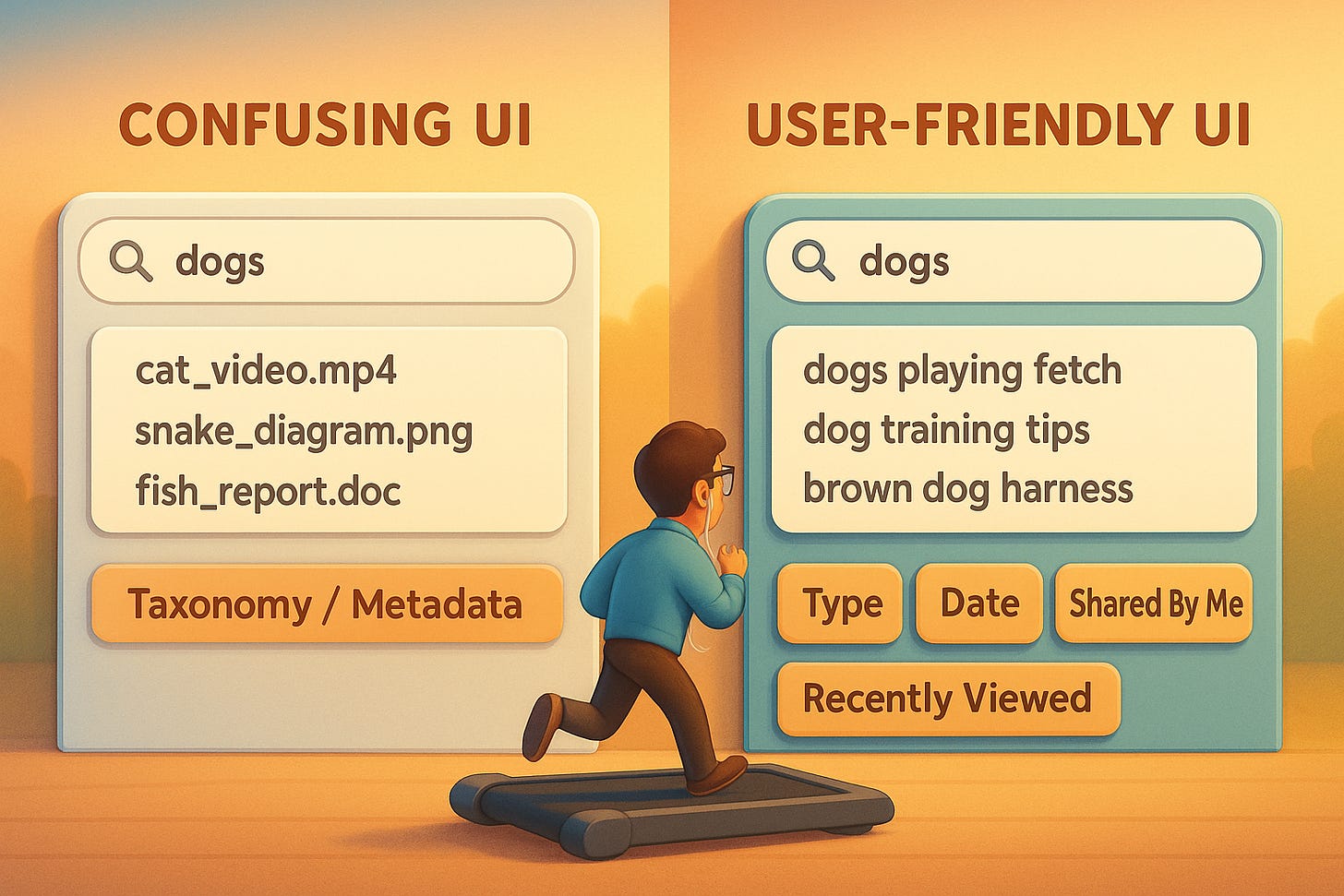When “Search” Isn’t Actually Helping Users Find Anything
Why Search Fails
Quick Take
A search bar only works if it understands how people think and describe things.
Most search failures aren’t technical; they’re language alignment problems.
This week’s Gameboard Challenge
🎯 Gameboard Feature: Last Week’s Star Solution
Challenge Recap:
Lara installs a new AI journaling app. Before she can even write her first note, a pop-up asks her to “Grant microphone and camera access.” She hesitates and quits.
Featured Response - by IKRA
Possible Root Cause #1:
It disrupted the user’s journaling flow - Lara downloaded the app to write, not record. The notification felt jarring and unrelated to her goal.
Possible Root Cause #2:
It felt invasive - requesting camera and mic access before any context compromised her sense of privacy and trust.
Suggested Fix:
Instead of forcing permission upfront, place small camera and microphone icons within the interface. When tapped, prompt a message with context:
“Enabling camera will allow you to include photos in your journal. Please enable in settings if you’d like to add images.”
A calm, transparent moment - not a demand.
👏🏽 Brilliant thinking, Ikra. You nailed both the emotional trigger and the trust-first solution.
Why Users Can’t Find What They’re Searching For
We’ve all been there:
You search for something simple like “blue dress” or “meeting notes” and the results feel… wrong.
Not because the system is broken.
But because the system is built around internal labels instead of user language.
Teams often categorize content using the language they use internally.
Users search with the language they use in real life.
That gap?
That’s where search frustration lives.
Why Search Fails
Internal naming ≠ user naming.
If the product team calls something “Document Workspace,” but users say “Notes,” search breaks.Filters are too abstract.
People think in goals (“I need the presentation for today”), not metadata (“File type: PPT, Date: Yesterday”).Search doesn’t handle messy input.
Typos, partial phrasing, slang, synonyms - real search behavior looks nothing like query-perfect input.
How to Fix It
Collect the terms users actually use.
Design filters that feel human, not technical.
Make search forgiving - autocomplete, suggestions, approximate matches.
In UX, search isn’t about algorithms. It’s about speaking the same language as the person asking the question.
“Good search doesn’t demand perfect wording. It works with how people naturally think.”
Resources:
The 1-Day UX Career Breakthrough Workshop
📍 Alexandria, VA | Nov 22 | Only 30 seats available
If applications are going nowhere, interviews feel inconsistent, or your portfolio just isn’t landing… the problem isn’t your ability. It’s the strategy behind how you’re presenting it.
In one focused day, UX leaders Joe Natoli and Rajeev Subramanian will help you rebuild that strategy , clearly, confidently, and step-by-step.
You’ll walk away with:
✅ A stronger LinkedIn profile that speaks to hiring managers
✅ A personal brand that actually attracts recruiters
✅ Outreach and interview practice that feels natural, not forced
✅ A 90-day roadmap that points directly to your next UX role
🎯 One day. Clear direction. A career that moves forward again.
🏆 App of the Month: Survival Budget
A financial safety checker built for calm, not control.
Most budgeting apps want to track every dollar.
This one just wants to answer one question:
“Am I going to be okay this month?”
Survival Budget, created by Janiré Castillo (founder of Articulate Digital), helps people understand what’s affordable without the guilt or overwhelm.
Enter your essentials, see what’s covered, what’s flexible, and what can wait — all in a clean, color-coded snapshot.
💡 Why we love it:
Because good design makes you feel something, and this app feels like a deep breath for your finances.
UX Gameboard Challenge
Scenario
Sam is trying to find last month’s project brief in her company’s workspace app.
She searches “Brand Brief.”
She tries “Campaign Plan.”
She tries the client’s name.
Still nothing.
She gives up and messages a teammate: “Do you have the link?”
Your Challenge
Identify 1–2 root causes of this UX failure (beyond “bad search”).
Suggest one UX improvement that helps users find what they came for without relying on perfect keywords.
Think you know the answer? Drop it in the comments for a chance to be featured in next week’s Gameboard reveal!
Quick Tip: Watch How Users Describe Things
During interviews, usability tests, or even Slack messages, write down the exact words users use when they talk about tasks.
Make those your labels.
Not the internal ones.
Language is UX.
See you next Wednesday.
Thanks for learning and growing with us, one insight at a time.





